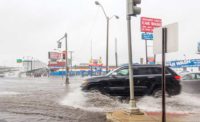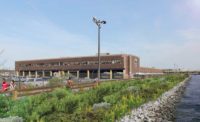With two consecutive nor'easters pummeling the East Coast less than two months after January's "bomb cyclone,"—and another storm forecast for March 13 that is expected to drop more than a foot of snow—architects, engineers, politicians and environmental groups in Massachusetts are calling for state regulators to force building owners to protect their properties from extreme wind, flooding and heat related to climate change and sea level rise.
"Whether we like it or not this is going to happen again and again," says Blake Jackson, Stantec's Boston-based sustainability design leader.
Some developers are concerned that sweeping regulations could hurt business, while others warn that such standards based on the outdated information currently informing building codes could do more harm than good.
The issue is more than about development though. Boston faces projections for 9 in. of sea-level rise by 2030 and 36 in. by 2070. "There are issues about property damage and about flooding, but, first and foremost, public safety issues posed by flooding are going to be greater and greater," says Jay Wickersham, president of the Boston Society of Architects and Massachusetts' former assistant secretary of environment affairs. Resiliency regulations are crucial to protecting the public, he says.
Currently, owners and developers in Massachusetts implement elements to make buildings more resilient on a voluntary basis. The Massachusetts building code—which is based on the International Building Code (IBC)—has no comprehensive mandates for climate resiliency, according to the American Institute of Architects Massachusetts, the Boston Society of Architects (BSA) and environmental groups such as Boston Harbor Now and the Conservation Law Foundation (CLF). And unlike states such as California and New York, Massachusetts municipalities don't have the authority to set local building codes above and beyond state regulations, the groups say.
Jackson says the state building code could be updated to include requirements for native landscape/xeriscape as a percentage of a site to help absorb flooding impacts. He also suggests more stringent stormwater retention specifications to eliminate runoff. "Personally, I do not like regulations," Jackson says, "but we've proven we need some sort of regulation because we're not going to do it on our own."
Justin Krebs, of Boston-based KIG Real Estate Advisors, disagrees. He says he's a "100% supportive" of addressing the "change in climate and weather circumstances," but that it's important to find a balance between good regulation and the market "having the discipline to regulate itself. There is always that ebb and flow between too much regulation and the potential impacts of that."
He says investors, debt lenders, buyers and insurance companies will demand that developers adopt resiliency measures. "Institutional investors are hypersensitive to protecting their investments," he says.
State of Data
The building code in Massachusetts—like in most states—is currently guided by outdated—and reportedly inaccurate—Federal Emergency Management Agency floodplain maps, says Deanna Moran, the CLF's director of environmental planning. She says using FEMA maps that rely on historic weather data doesn't allow the codes to account for the frequency of future floods, heat waves and precipitation. "In most places [FEMA] hydraulic analysis are 30 years old," Moran says. "Building code floodplain construction is based on those zones."
Massachusetts is currently compiling more "forward-looking" data, Moran says, as part of a larger resiliency effort launched two years ago. She says the data is expected to be rolled out in September and that the building code would be more useful if it replaced FEMA data with the state's new data.
The CLF and BSA say using these future projections for site design instead of historical flooding will better protect a new building during its lifespan by informing elevation, stormwater management and buffer zone designs to combat sea level rise, storm surge and extreme precipitation.
Swapping the data is important to "make sure we are using the best data and to level the playing field and to protect public safety," Wickersham says.
Don Ghent, principal and design realization leader at Gensler DC, says IBC is doing a good job incorporating information without being too reactive. "To say the code is not looking ahead would be wrong," he says.
Ghent adds that several MidAtlantic states such as Delaware and Maryland—which received major wind damage from storms earlier this month—allow municipalities to strengthen local code above state minimums. He says that many coastal communities in Delaware, for example, have codes requiring waterfront homes to be built on piles.
Massachusetts will begin reviewing its building code this summer as part of a regular review.
"I suspect [resiliency] will be in the forefront of people's minds," says Meera Deean, an architect by training and the planning director for Boston Harbor Now.
Carrot vs. Stick
Voluntary efforts to address resiliency in the region have gotten mixed reviews. Last year, the Boston Planning & Development Agency approved a resiliency policy that requires owners to "consider present and future climate conditions in assessing project environmental impacts, including carbon emissions, extreme precipitation, extreme heat and sea level rise," according to the BPDA's website.
But the so-called resiliency checklist isn't a mandate, it merely says owners must identify on their building permit "strategies that eliminate, reduce and mitigate adverse impacts including those due to changing climate conditions."
Andrea Love, the previous past board chair of the U.S. Green Building Council's Massachusetts chapter, called the checklist "pretty loosey-goosey." She says it only requires developers to say what they are "thinking" about doing. Love, who is also the director of building science at Payette, says, "It doesn't ask questions or prod you to think on a neighborhood scale."
Deean says while the city gets "beat up" for its "voluntary checklist," they are doing as much as they can from a legal standpoint to make sure developers consider climate change. "Until everything else catches up, there's only so much they can do," she says, referring to the state building code.
City officials are also using the zoning code to push for more resilient development. For example, officials negotiate and incentivize owners to elevate a building in the floodplain by 5 ft in exchange for being allowed to build taller. But, Moran says, "some developers are not moved by incentives. By moving from incentive to requirements, you are closing that gap."
Others argue that developers could help fund a four-mile seawall in the Boston Harbor instead of providing setbacks.
The Boston City Council also recently called for a hearing on flooding. Representing Charlestown, East Boston and the North End, Boston City Councilor Lydia Edwards' district covers more coastline than any other district. She says developing on the waterfront is a privilege that should require owners to not just protect their own properties but to help protect their neighbors as well.
"It's not an either or, you can have it both ways," Edwards says. "I just want [developers] to be more creative. I want the city to be pushing." She says resilient design "shouldn't be the exception to the rule … it should be the rule."






Post a comment to this article
Report Abusive Comment